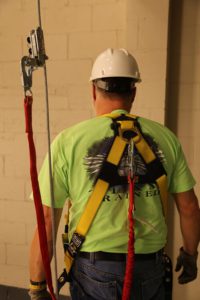
An image from a street-level perspective looking up at Chicago’s Willis Tower and other tall buildings.
The number of elevators in use in the United States, Canada, and the rest of the world has been growing steadily in recent years, and advancements in elevator modernization have seen similar progress. Given that tens of millions of people ride elevators every day, ensuring that the traveling public is safe while riding is critically important.
As new technologies emerge, elevator safety requirements are changing to keep pace with these advancements. Ensuring elevators are modernized to keep the riding public safe is an important task undertaken by the elevator constructors who build, maintain, service, modernize, and inspect conveyance systems across the country.
To find out more about this important job, let’s take a closer look at the reasons why elevators must be modernized, how to know it is time to call the professionals to upgrade elements in an elevator’s system, and how these modernizations are carried out.
Safety First
Under no circumstances should a building owner, general maintenance worker, or anyone without the appropriate training and experience ever attempt to fix an issue with the elevator in their building, at their place of work, or anywhere else. If an elevator user recognizes that an elevator is broken, damaged, or malfunctioning, they should speak to the building manager, who should in turn contact the professionals. This point can’t be understated, as the safety of the riding public is paramount.
Elevator construction and maintenance work is heavy-duty manual labor that requires years of elevator training courses and on-the-job experience under the supervision of qualified, trained professionals. The reason that this professional training must be so rigorous is that faulty or outdated elevators can be extremely dangerous for the people who ride or work on them.
Let’s look at some common factors that necessitate a system upgrade or other form of elevator modernization.
When and Why Elevators Must Be Modernized
Given the complex electronic and mechanical components that make up an elevator’s system, regular maintenance is extremely important. But even elevators that are regularly maintained are likely to require modernization at some point – especially if they are more than 20 years old. Many things can happen that may warrant modernization, but generally speaking, they fall into seven different categories.
Here are some reasons your building’s elevator system may need an upgrade:
Unreliable Service
If an elevator can’t be relied on to transport people quickly, reliably, and safely to their chosen floor, and the elevator is up to date with its recommended routine and preventative maintenance schedule, some sort of elevator upgrades will be required.
Frequent Shutdowns or Entrapments
If an elevator regularly shuts down, or the traveling public is often stuck inside the elevator, some form of modernization is needed.
Code Violations that Have Been Cited by an Inspector
The American Society of Mechanical Engineers (ASME), along with the National Fire Protection Association (NFPA/NEC) writes the code for elevator safety in the United States. If an elevator inspector identifies any violations of the ASME or other code standards adopted in that jurisdiction, the elevator must be modernized in one way or another.
Excessive Wear
If an elevator is visibly worn, outdated, or shoddy, modernization work is needed.
Inability to Acquire Replacement Parts
If an elevator in need of maintenance cannot be fixed due to a lack of available or affordable replacement parts, the elevator’s system or some elements of it must be modernized.
Excessive Energy Consumption
Often, older elevators need to be modernized to meet certain energy efficiency standards. This is becoming more common as the industry moves toward becoming more green.
In essence, an elevator needs to be modernized any time it isn’t keeping up with the needs of the building. If potential safety issues aren’t addressed, there is a real risk of endangering the people who use these conveyances as a mode of transport. But what’s actually involved in elevator modernization? Let’s take a look at the steps involved.
What Does Elevator Modernization Actually Involve?

An image showing a controller during an elevator modernization project.
Elevators must be modernized and kept up to code standards to guarantee the safety of their end users – the riding public. When any of the reasons for modernization described above come into play, building managers, owners, or other relevant authorities must take steps to ensure this safety.
When an elevator is found to be out of compliance with local, regional, or national code regulations, an inspector can “red tag” the elevator. This means that the elevator may not be used, and a building manager or owner could find themselves in legal trouble should they disobey this order. They could even lose their ability to hold occupancy of the building due to an unsafe elevator.
Rarely will a building require a completely new unit or model; changing and upgrading elevator components is typically what’s required. Whenever there is an upgrade, the elevator must be brought up to code. Ultimately, the degree to which a unit must be brought up to code will be decided by the relevant jurisdictional authorities in accordance with the particular set of code standards adopted in that jurisdiction.
Because of the inherent risk that can be involved in riding elevators, the elevator industry takes a strict, no-nonsense approach to safety regulations and standards.
Learn More About the Elevator Industry
The elevator industry boasts tens of thousands of brothers and sisters throughout North America who dedicate their professional lives to ensuring the safety of every person who sets foot on an elevator. The International Union of Elevator Constructors (IUEC) represents the most qualified and trained elevator workers in the world, trained by the National Elevator Industry Educational Program (NEIEP).
For more information about elevator modernization and the elevator industry as a whole, be sure to check out our other articles.












 The Personal Fall Arrest System (PFAS) is comprised of three main pieces: an anchorage point, a body harness, and a lanyard. It is the standard mandatory PPE that elevator technician/constructor mechanics and apprentices must use whenever working where a
The Personal Fall Arrest System (PFAS) is comprised of three main pieces: an anchorage point, a body harness, and a lanyard. It is the standard mandatory PPE that elevator technician/constructor mechanics and apprentices must use whenever working where a 